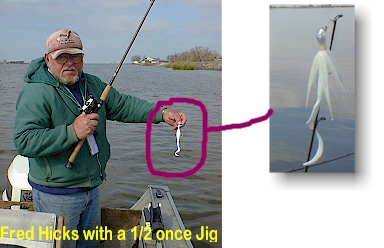By: Mark Wilson
Jigging (not spooning) for stripers...
 Here it is, the middle of winter. The local rivers are fluctuating
in color,
Here it is, the middle of winter. The local rivers are fluctuating
in color,
height and temperature. The striped bass has all but disappeared
until the
spring run starts. I want to catch a striper, lots of stripers! What
do I
do? The Port of Sacramento is an option. So is the San Joaquin
River,
including all of it's waterways, flooded islands and tracts. I'm
choosing
the San Joaquin River and it's many options, pending weather
conditions.
There is a multitude of wildlife to see also. Geese, ducks, hawks,
beaver,
otters, raccoons and other animal and birdlife abound. I think the
San
Joaquin River has a lot more to offer than the Port of Sacramento.
When the Sacramento River runs cold and dirty the striper fishing
turns off
for a while. A lot of stripers show up over on that other river, the
San
Joaquin. I head for the San Joaquin River and its many waterways,
because
it is normally clearer, and I can find some schools of stripers,
here and
there. A typical day's run for stripers might include 45 miles of
waterways.
The San Joaquin offers a lot of options for catching stripers at
this time
of year. Those options are bait fishing, trolling, spooning, casting
plugs
and lures, and JIGGING!
The stripers I am targeting are of schoolie size. That is, stripers
from 13"
to around 10 - 12 pounds. Occasionally, we hook into stripers up in
the 15#
to 30# class, or even larger, sometimes (Largemouth bass will bite
the jig
also).
I like to use white jigs, with a 6" worm trailer, between 1/2
ounce and 1
ounce, depending upon the depth of water and current speed. Most of
the
time, the 1/2 oz. white jig works well. I work both incoming and
outgoing
tides.
I prefer to use 6-1/2' to 7' bait casting rods, capable of handling
lines
between 12# and 20# test line. I use bait casting reels which are
capable
of handling around 100 - 150 yards of 12# to 20# test lines (lighter
line for
the lighter jigs). Spinning gear will work also. I do a lot of long
casting, so the reel should be of good quality, to let you cast long
distances. I attach my jig to my line with a snap or snap swivel.
Find a good map of the delta showing contours. You want to target
water
depths around 10' or less. Look for shallow depths around shoals,
weed
lines, tule berms, and on the ends of islands. You want the outgoing
or
incoming tides flowing pretty strong along side, over, or into those
locations. Position the boat off in the deeper water and cast into
the
shallower water. It is important to work your jig. Do not just do a
steady
retrieve. Work your rod back and forth, and/or reel and stop, reel
and stop,
to give that stop and go and falling action to the jig. The erratic
retrieve
is what triggers the striper's attack on your jig.
You want good water clarity. You should be able to see your jig down
to, at
least, 1-1/2' to 2', or more. If it is muddy, the striper cannot see
the
jig. Water temperature is not critical. I catch stripers on
artificial
lures between 47 degrees and 70 degrees. Spraying the jig with an
artificial
smell is an option too.
On the San Joaquin River you can target areas to fish, anywhere
between Broad
Slough to Stockton. The stripers are there somewhere. Just look for
the
shallow spots, with current. If you don't get bit, go to another
spot. When
you get on a school or stripers, the bite can last for a few minutes
or
hours. Or, the bite can turn off, and be right back on an hour
later. Those
stripers can really disappear when they want to.
Now, you got the idea. Go out and catch yourself a striper on a jig.
It can
be really fun!!
Good luck and Catch you later - Mark.
|
|